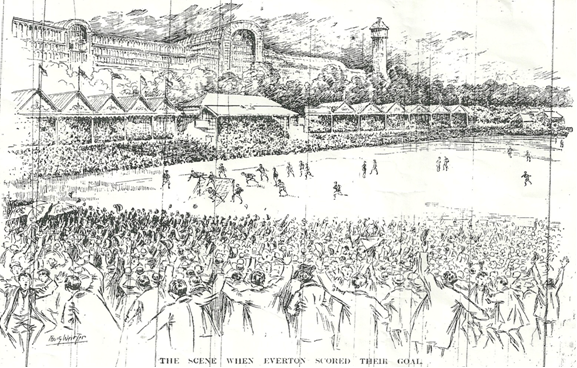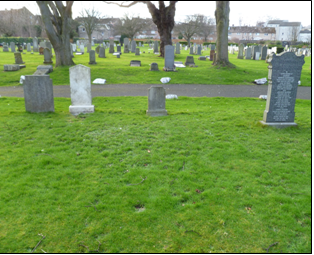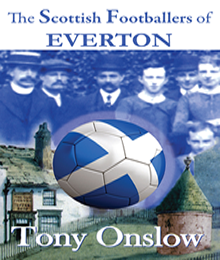Alexander Simpson Young was born in September 1880 at Lochside in the small Stirlingshire town of Slamannan. He was the son of local born coal miner Peter Young and his wife Agnes. Sandy began playing football in the Stirlingshire Junior League from where he was invited to join Scottish League club St Mirren at Paisley. He spent one season with the Buddies before returning home to play regional football with Falkirk. In April 1901 Everton made their first visit to the Falkirk ground and played out a 2-2 draw. The Everton directors were impressed with the form shown Sandy Young who, following a trail period, accepted an invitation to join them next season.
He cut his teeth in the reserve side before making his debut, 28-9-1901, against Aston Villa at Birmingham and immediately returned to reserves. He then made history by scoring a goal in the in the first ever FA Cup tie to be played between Everton and Liverpool. Sandy played only a moderate part in his first season with Everton that saw the club narrowly edged out of the league championship by Sunderland. His goal tally increased gradually over the next two seasons as Everton, 1903-04, finished third in the table and runners up to Newcastle United in the season that followed. The scoring exploits of Sandy Young had not gone a miss with the Scottish selectors and, 1-4-1905, he won his first International cap against England at the Crystal Palace. His finest moment however came one later year when he lined up with his Everton team mates to face Newcastle United in the 1906 FA Cup at the Crystal Palace in London. The game was 70 minutes old when Sandy latched on to a centre from Jack Sharpe to score the only goal of the game to land Everton the trophy for the first time in their history.

Next season Sandy, who continued to find the net for Everton, won his second International cap when he represented Scotland against Wales on the Racecourse Ground in Wrexham. He remained the firm favourite with the Everton fans until his departure for London where he joined Tottenham Hotspur in the spring of 1911. Sandy Young had played 314 league and cup games for Everton and was, to date, the clubs leading scorer with 125 goals. His news of his departure, which was anticipated, was recorded in a local newspaper….
The Everton crowd will miss him – him being Sandy Young, who has left the Mersey city, after a stay of eleven years. No more shall we see the Scot hitching up his “breeks no more shall we see him guarding the solitary lock of hair that adores his brow. Young will be missed. Long ago I pointed out he was an excellent advertisement for the club, though I realised that his style of play bewildered his opponents, and his own side, and at times he exceeded the reasonable limits of dribbling. Sandy has gone to Tottenham (£700), and has bone out the exclusive statement made by this paper many days ago. (Liverpool Echo, 9-6-1911 … .)
The Everton fans however, had not seen the last of Sandy Young and thousands of them turned out to welcome him when, on the opening match of the season, when he re-appeared at Goodison Park in the colours of Tottenham Hotspur. When the “immortal Sandy” appeared on the field the reporter, working for the Liverpool Daily Post remarked that… his enthusiastic reception on Saturday must have astonished the Spurs, and proved to the old Blue that he still retains a warm place in Liverpool hearts . Everton, when the match commenced, had built up a 2-goal lead when they lost their John Maconnachie with an injury. The visitors then hit back and equalized in the dying minutes with a goal that was scored by no other than Sandy Young. The game ended 2-2. Nevertheless Sandy Young, who did not settle in London, soon left White Hart Lane and returned north where he spent one season with Manchester City. He later moved back to Merseyside and played non-league football with South Liverpool.
Sandy Young, his playing days at an end, emigrated to Australia where he bought block of land next to his brother John at in state of Victoria. The two men, it was reported, frequently argued about the debt of money that was owed Sandy by his brother until, one December morning, things came to dreadful conclusion. Sandy Young shot his brother and then turned the gun on himself A passing neighbour heard the shots and ran to help both men before informing the local police. Sandy was taken to the local hospital were he later recovered but his brother, who was not so fortunate, died of gun shot wounds. Sandy Young was then transferred to Bendigo Jail where he was detained and changed with the murder of his brother.
Sometime later a leading Liverpool newspaper received a visit from to two Ladies from North of the Border whose concern for their brother they expressed, it would appear, in a mellifluous Scottish accent. They won the compassion of a local journalist who told his readers of the reason why they had made the long journey to Liverpool.... I had a visit this morning from the sisters of Sandy Young, two charming Scottish Lassies, who were naturally quite heart broken over the trouble. They wished me to say how much they appreciated the kindly sympathy of the Liverpool football public, with which sympathy they were much impressed. They have come to the city from their home in Avonbridge, Stirlingshire, and I was fortunately able to put them in direct touch with the Everton secretary, Mr. Cuff. I understand that the Everton club is prepared to do anything possible to assist Young's defence and they have already opened up depositions with authorities in Melbourne to that end.
The Misses Young, in the course of my conversation with them, said that the last news they have of Sandy, is at Christmas when they received a letter from him. He then appeared to be going on all right and there was no indication of anything in the nature of approaching trouble. Sandy, they said, was always of a melancholy temperament, and they added – Whatever he did, he must have been driven to it, for he was always good. Their Mother, they added, who is approaching her seventieth year, was terribly upset by the news, which had reached her through the medium of the newspapers, and concerning which, they have, as yet, not learned anything from any other source.
The sisters interview with Mr. Cuff was of a personal nature, though they informed subsequently that the Everton secretary gave them every assurance that anything the Everton club do in the way of assisting Sandy in his defence, by the way of evidence or any other way, would be willingly done. Both the misses' Young were very much affected by the reception extended to them in Liverpool, to which City they are complete strangers. I took the opportunity of seeing them off to Edinburgh by the 12:40 train, and they again were expressive of their appreciation of the kindly courtesy of the Everton secretary. (Evening Express, 29-1-1916.)
On the 21 June 1916, Sandy Young appeared in court to answer the charge of Murder. The widow of his brother, Agnes Calder Young was summonsed to give evidence. She told the court that her husband began dairy farming in Tongela in 1911 and Alexander Young later came from Scotland, and bought the adjoining block. There was frequent friction between the brothers over money matters and the working of the blocks -. On the morning of December the 1 st she heard a shot fired and later saw her Husband lying wounded. She also told the court that “Alexander had lent John £250 to come to Australia and later had sent him £100.
Alexander Young said on the night before the shooting, “I missed one of my guns and I suspected my brother of having taken it. We had a quarrel about money matters that night and on the 1st of December I loaded my gun for protection. I went to the cowshed where I asked him about my money. John got up and attacked me with shovel. I ran away and he followed I stopped and said Stand or I will shoot. He made a rush and said come on fire. I fired and he fell. I took the shovel and then went to my house and shoot myself. I do not remember anything after that”.
The jury later returned a verdict of manslaughter and Sandy was given a period of three years in Bendigo Jail. The Judge, when sentencing him said he had taken in to consideration the affidavits made by persons who knew him in Scotland in which it was stated that Young was subject to fits of temporary insanity. However, the Judge also stated that although he was desirable for the prisoner, during his sentence, to regain his health he warned that if the authorities were satisfied that at the end of three years that his health had been restored, then it was possible that his term may be extended. Sandy then spent nearly three years in jail before being transferred, for a period of recuperation, to the McLeod Prison Farm on French Island off the coast of the State of Victoria.
The next sighting we have of Sandy Young is when he boards the SS Ceramic at Melbourne for his journey home to Britain. The date is September 1920. He is listed as passenger number 81 and gives his age as 39. He eventually arrived in Edinburgh where he took up residence at 43 Abercorn Terrace and worked in a local quarry. It would appear that, in later life, he was cared for by his sister Helen who lived close by and it is her who notified the authorities of his death on 18 th September 1959. Sandy Young died, aged 78, at The Holly Lodge, York Road in Edinburgh and was buried at Seafield Cemetery. There is no headstone on his grave.

The last resting of Sandy Young at Seafield Cemetery, Edinburgh.
Alex Simpson Young (Sandy)
By "Tony Onslow"
Alex Simpson Young (Sandy)
The Tony Onslow Collection - E-Mail - Themanfromthehillcountry@hotmail.com...
Everton Independent Research!
